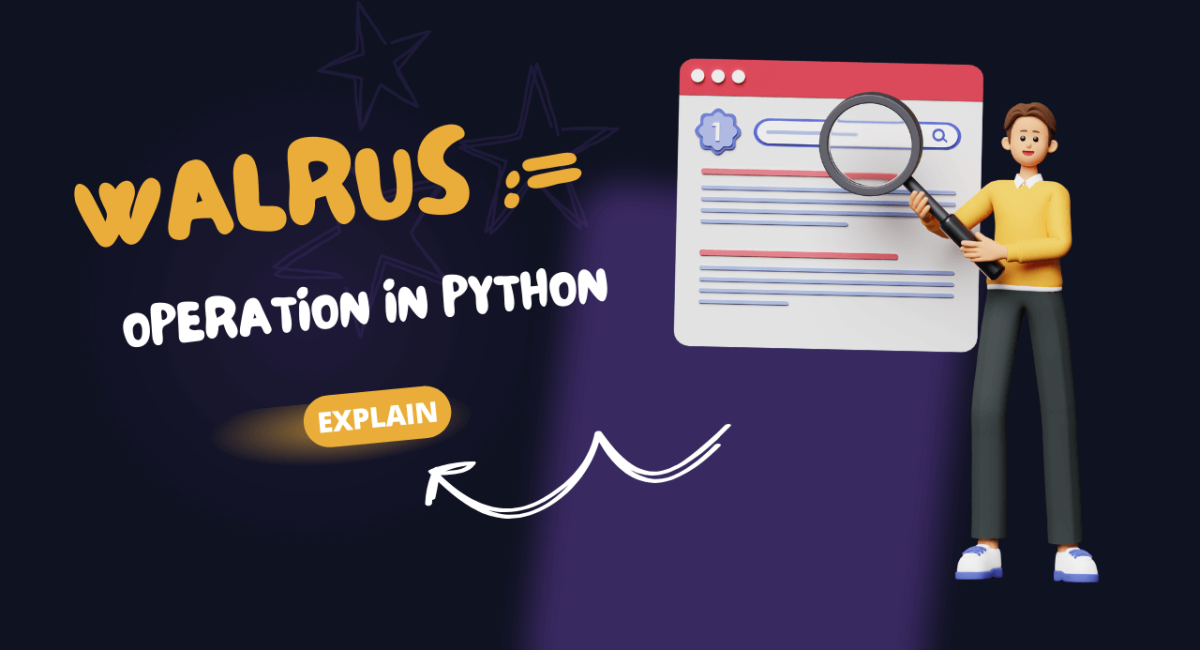Python programming is known for its readability and concise syntax, which makes it a favorite among developers. The introduction of the walrus operator (`:=`) in Python 3.8 took this simplicity to a whole new level.
In this article, we will explore the concept of the Python walrus operation and how it can streamline your code by allowing you to assign values within expressions. Let’s dive in!
Understand the Walrus Operator
The Walrus Operator, denoted by :=, is a relatively new addition to Python, introduced in PEP 572. It serves as an assignment expression that allows you to both assign a value to a variable and use that value in an expression in a single line.
def factorial(n):
return 1 if (n := n - 1) == 0 else n * factorial(n)
This can greatly improve the clarity and conciseness of code, especially in situations where an assignment is needed within an expression.
How Does the Walrus Operator Work?
The walrus operator is relatively straightforward. It enables you to assign a value to a variable within an expression.
This assignment takes place at the same time the expression is being evaluated. This eliminates the need to write separate lines for assignment and evaluation, leading to more concise and efficient code.
Traditional Approach
# Using a traditional approach without the walrus operator
while True:
user_input = input("Enter a value (or 'q' to quit): ")
if user_input == 'q':
break
print("You entered:", user_input)
With Walrus approach
# Using the walrus operator to simplify code
while (user_input := input("Enter a value (or 'q' to quit): ")) != 'q':
print("You entered:", user_input)
Benefits of Using the Walrus Operator
The primary advantage of the walrus operator is evident: it reduces the need for redundancy in your code.
This becomes particularly beneficial when dealing with complex conditions or loops. By integrating assignment into expressions, you can enhance the readability of your code and reduce the chances of errors.
Common Use Cases
If-else
The walrus operator (:=) in Python offers a notable advantage when used in combination with if and else conditions.
It allows you to both assign a value to a variable and use that value in a condition within the same expression. This can lead to more concise and readable code.
Here’s an example to illustrate the advantage of the walrus operator with an if and else condition:
# Without walrus operator
number = int(input("Enter a number: "))
if number > 10:
result = "greater than 10"
else:
result = "less than or equal to 10"
print(f"The number is {result}.")
# With walrus operator
if (number := int(input("Enter a number: "))) > 10:
result = "greater than 10"
else:
result = "less than or equal to 10"
print(f"The number is {result}.")
nested if-else condition
In the below example, the code simulates a daily routine by checking the tasks in the daily_tasks dictionary and performing the corresponding actions based on the available time allocated for each task.
Without walrus operation:
daily_tasks = {
"coding": 3,
"reading": 2,
"exercise": 1,
}
def code_hours(hours):
print(f"Coding for {hours} hours.")
return True
def read_books(hours):
print(f"Reading for {hours} hours.")
return True
def do_workout(hours):
print(f"Doing workout for {hours} hours.")
return True
activity = "coding"
hours = daily_tasks.get(activity, 0)
if hours >= 2:
success = code_hours(hours)
if success:
to_enjoy = "Coding achievement unlocked!"
else:
activity = "reading"
hours = daily_tasks.get(activity, 0)
if hours >= 1:
success = read_books(hours)
if success:
to_enjoy = "Knowledge boost achieved!"
else:
activity = "exercise"
hours = daily_tasks.get(activity, 0)
if hours:
success = do_workout(hours)
if success:
to_enjoy = "Healthy day well spent!"
else:
to_enjoy = "Relax and enjoy your free time."
print(to_enjoy)
With walrus operation:
daily_tasks = {
"coding": 3,
"reading": 2,
"exercise": 1,
}
def code_hours(hours):
print(f"Coding for {hours} hours.")
return True
def read_books(hours):
print(f"Reading for {hours} hours.")
return True
def do_workout(hours):
print(f"Doing workout for {hours} hours.")
return True
if (hours := daily_tasks.get("coding", 0)) >= 2:
if code_hours(hours):
to_enjoy = "Coding achievement unlocked!"
elif (hours := daily_tasks.get("reading", 0)) >= 1:
if read_books(hours):
to_enjoy = "Knowledge boost achieved!"
elif (hours := daily_tasks.get("exercise", 0)) > 0:
if do_workout(hours):
to_enjoy = "Healthy day well spent!"
else:
to_enjoy = "Relax and enjoy your free time."
print(to_enjoy)
The first example follows a more traditional approach, assigning and reassessing variables throughout the code.
The second example utilizes the walrus operator, which helps streamline the code by combining variable assignment with condition checks, leading to a more compact and arguably more readable code structure.
While Loops with the Walrus Operator
Consider scenarios where you need to read data from a stream or user input until a certain condition is met.
Traditionally, this requires defining a variable outside the loop to control its execution. With the walrus operator, you can streamline this process:
while (line := input()) != "stop":
# Process the line
List Comprehensions Enhanced by the Walrus Operator
List comprehensions are a concise way to create lists in Python. The walrus operator can make them even more powerful:
numbers = [x for x in range(10) if (x := some_function(x)) % 2 == 0]
Potential Caveats and Considerations
While the walrus operator is a valuable tool, it’s essential to use it judiciously. Overusing it can lead to code that is difficult to understand, defeating its purpose of enhancing readability.
Best Practices for Using the Walrus Operator
To make the most of the walrus operator, follow these best practices:
- Use it when it genuinely enhances readability.
- Avoid using it excessively within a single expression.
- Consider its compatibility with earlier Python versions if your codebase needs to support them.
Exploring Compatibility: Python 3.8 and Beyond
The walrus operator made its debut in Python 3.8. Therefore, if your project requires compatibility with earlier versions, alternative approaches must be considered.
Performance Implications
The performance impact of the walrus operator is negligible in most cases. However, like any language feature, it’s wise to profile your code to ensure it meets your performance requirements.
Here are some key points to consider:
- Balance Readability and Performance: The walrus operator is great for simplifying code and making it easier to follow. However, be cautious when using it extensively within complicated expressions, as it might confuse others who read your code later.
- Assignment Overhead: Assignments involving the walrus operator come with some overhead compared to regular variable assignments. The operator involves additional logic for both assignment and evaluation, which could potentially slow down your code in tight loops or critical sections.
- Python’s Optimizations: Python tries to optimize code, but the effectiveness varies based on the specific code and Python version you’re using.. The walrus operator’s impact might be reduced by these optimizations, but don’t rely on them completely.
- Maintainability: While concise code is desirable, code that’s too compact can become hard to maintain over time. If your code gets too complex because of the walrus operator, debugging and updates might become challenging.
- Profile for Bottlenecks: If you’re worried about performance, use tools like cProfile to spot performance issues. This helps you identify places where the walrus operator could be affecting speed.
Conclusion
The Python walrus operator (`:=`) is a game-changer for developers aiming to write concise, readable, and efficient code. By allowing variable assignment within expressions, it reduces redundancy and enhances code elegance.
Remember to use it judiciously and enjoy the benefits of cleaner code without sacrificing readability.
FAQs
The walrus operator (`:=`) enables you to assign values to variables within expressions, streamlining your code and reducing redundancy.
While the walrus operator has negligible performance implications, it’s essential to profile your code to ensure it meets performance requirements.
No, the walrus operator was introduced in Python 3.8 and is not available in earlier versions.
It’s recommended to use the walrus operator judiciously within an expression to maintain code readability.
Stay updated with the official Python documentation and developer community resources to learn about new language features and best practices.
No, the Walrus Operator was introduced in Python 3.8, so it won’t work in older versions.
Yes, the Walrus Operator can be used with all variable types that are valid in Python.
In most cases, the impact on performance is negligible, as modern Python implementations are optimized to handle it efficiently.
While the Walrus Operator can simplify code, excessive use can lead to decreased readability. Use it judiciously.
Yes, you can use the Walrus Operator within lambda functions to enhance their conciseness.




